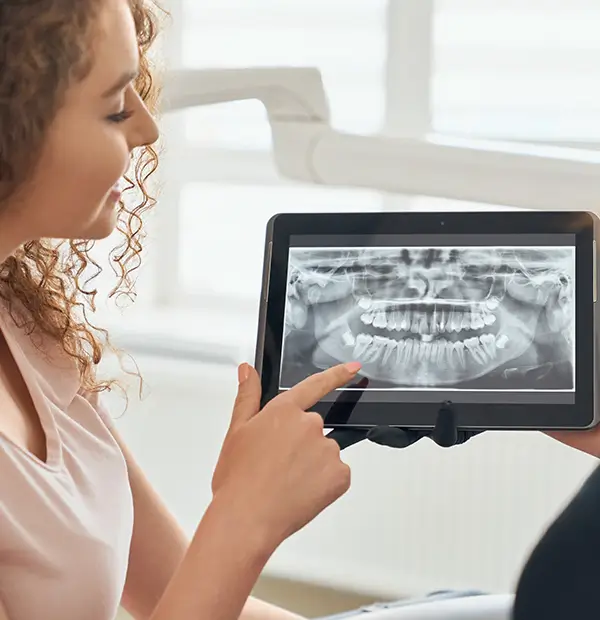Pediatric dental X-rays spot issues early, ensuring kids’ oral health. Learn their importance, types (bitewing, panoramic), safety (low radiation), and benefits.
Pediatric dental X-rays are tools dentists use to check children’s teeth below the surface. They catch problems early, protecting your child’s oral health. Safety concerns are common, but modern technology keeps risks low. This guide covers why X-rays matter, when they’re needed, types available, safety facts, and how to prepare your child for one at Lansdowne Pediatric Dentistry.
What Are Pediatric Dental X-Rays and Why Are They Important?
What Are Pediatric Dental X-Rays?
Pediatric dental X-rays are images taken of a child’s teeth, gums, and jaw using low levels of radiation. Unlike a regular exam where a dentist looks at the surface, X-rays show what’s happening underneath—inside the teeth, roots, and bones. They’re made just for kids, using smaller equipment and faster methods to suit their growing mouths. At Lansdowne Pediatric Dentistry, we use digital X-rays, which cut radiation even further and give clear pictures fast. The American Dental Association calls them a key tool for spotting issues early in children.
Why Are Dental X-Rays Important?
Dental X-rays, also known as radiographs, are crucial for diagnosing and treating various dental issues that are not visible during a regular dental examination. They help dentists to:
- Detect Cavities: X-rays can reveal cavities between teeth or under fillings, where they might not be visible to the naked eye.
- Monitor Tooth Development: For children, X-rays are essential to monitor the growth and development of their teeth. They can identify if teeth are coming in crooked, if there are any missing teeth, or if extra teeth are present.
- Assess Bone Health: X-rays help in evaluating the health of the jawbone and the roots of the teeth, ensuring there are no underlying issues.
- Identify Impacted Teeth: They can show if teeth are impacted (unable to emerge properly), which is especially important for canines and wisdom teeth.
- Plan Orthodontic Treatment: For children needing braces, X-rays provide detailed information to plan effective orthodontic referral and treatments.
- Detect Infections or Abscesses: X-rays can reveal infections at the root of the tooth or between the gum and the tooth.
When and How Often Should a Child Get a Dental X-Ray?
How Often Should a Child’s Teeth Be X-Rayed?
It depends on the child. The ADA and FDA suggest X-rays every 6-12 months for kids prone to cavities, or every 1-2 years for low-risk kids (ADA). Your dentist tailors this to your child’s needs.
When Do Children Need Their First Dental X-Ray?
Most kids get their first X-ray between ages 2 and 6, when back teeth touch and decay risk rises. Some need it earlier if problems show up.
Do Kids Need X-Rays If They Have No Cavities?
Yes, sometimes. X-rays check for hidden issues—like impacted teeth or jaw growth—not just cavities. They’re a safety net, even for healthy-looking smiles.
Types of Pediatric Dental X-Rays
Bitewing X-Rays – Best for Detecting Cavities
These show upper and lower back teeth in one shot. They’re great for finding cavities between teeth. Kids bite a tab to hold the film or sensor.
Periapical X-Rays – Focusing on Individual Teeth
These focus on one or two teeth, root to crown, to check for abscesses or root damage.
Occlusal X-Rays – Evaluating the Growth of Teeth
These capture all teeth in one jaw, showing placement and growth patterns.
Panoramic X-Rays – Full View of the Jaw and Teeth
A single image of the mouth, these tracks jaw development and spot missing or extra teeth.
Cephalometric X-Rays – Used for Orthodontic Evaluation
These side-profile shots help orthodontists plan braces by showing jaw and tooth alignment.
Cone Beam Computed Tomography (CBCT) – Advanced 3D Imaging
Rare for kids, CBCT gives a 3D view for complex cases like severe misalignment or surgery planning.
Are Pediatric Dental X-Rays Safe?
What Are the Risks of Dental X-Rays for Children?
Radiation is the main worry, but it’s tiny. A bitewing X-ray exposes kids to 0.005 millisieverts—less than a day of natural background radiation.
Radiation Exposure – How Much Is Too Much?
Type of X-Ray | Radiation (mSv) | Equivalent Background Radiation |
Bitewing (2 films) | 0.005 | 1 day |
Panoramic | 0.01 | 2 days |
CBCT | 0.03-0.06 | 6-12 days |
The EPA says yearly limits are 1 mSv for the public—dental X-rays are far below this (EPA).
What Safety Measures Are in Place to Protect Kids?
- Lead Aprons: Shield the body.
- Thyroid Collars: Protect the neck.
- Digital X-Rays: Cut radiation by up to 80% vs. film.
At Lansdowne Pediatric Dentistry, we use these to keep your child safe.
Benefits of Pediatric Dental X-Rays
Early Detection of Cavities and Tooth Decay
X-rays catch decay early, often saving teeth from fillings or extractions.
Identifying Impacted or Missing Teeth
They reveal teeth stuck under gums or absent ones, guiding treatment.
Evaluating Jaw Growth and Alignment for Orthodontics
X-rays show if braces or other fixes are needed for healthy bites.
FAQs About Pediatric Dental X-Rays
Will My Child Need an X-Ray at Every Appointment?
No. X-rays happen only when needed—usually once or twice a year, based on risk.
What If My Child Is Scared of Getting an X-Ray?
We explain it simply and use distraction. Dr. Sheyda Maghsoudi at Lansdowne Pediatric Dentistry keeps kids calm with a gentle approach.
How Does a Dentist Take an X-Ray on a Child?
Kids bite a sensor or film, hold still for seconds, and the machine snaps the image. It’s quick and painless.
Does Dental Insurance Cover X-Rays for Kids?
Most plans cover routine X-rays. Check yours—costs range from $25-$100 without insurance.
Final Thoughts – Ensuring Your Child’s Dental Health
How Regular Checkups and X-Rays Keep Kids’ Teeth Healthy
Checkups plus X-rays catch issues early, keeping smiles strong. They’re a team effort for your child’s future.
Schedule Your Child’s Pediatric Dental X-Ray Today!
Book an appointment with Dr. Sheyda Maghsoudi at Lansdowne Pediatric Dentistry today to ensure your child’s smile stays healthy! Call us now for expert care and peace of mind.
Give your child the best start—schedule their visit today!



